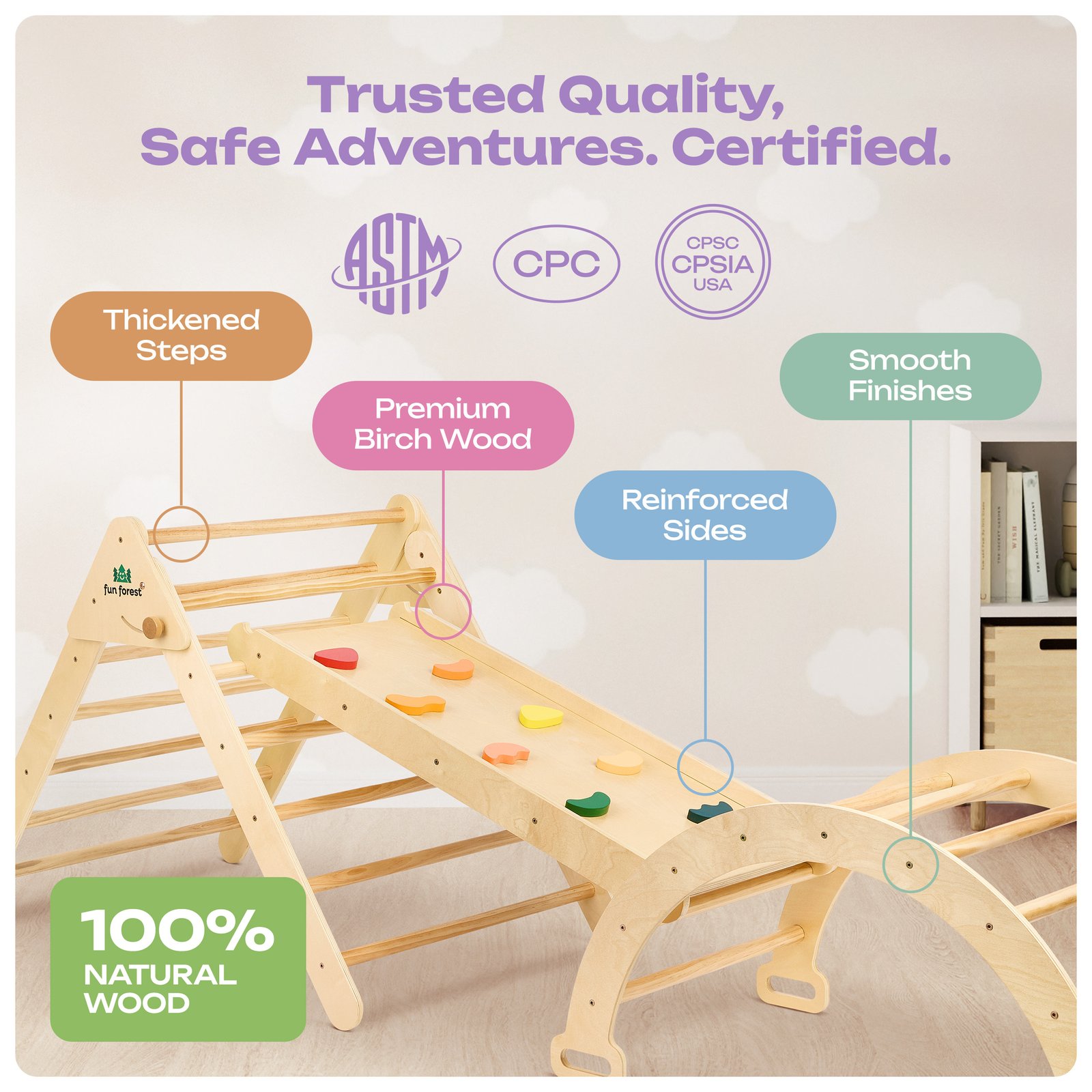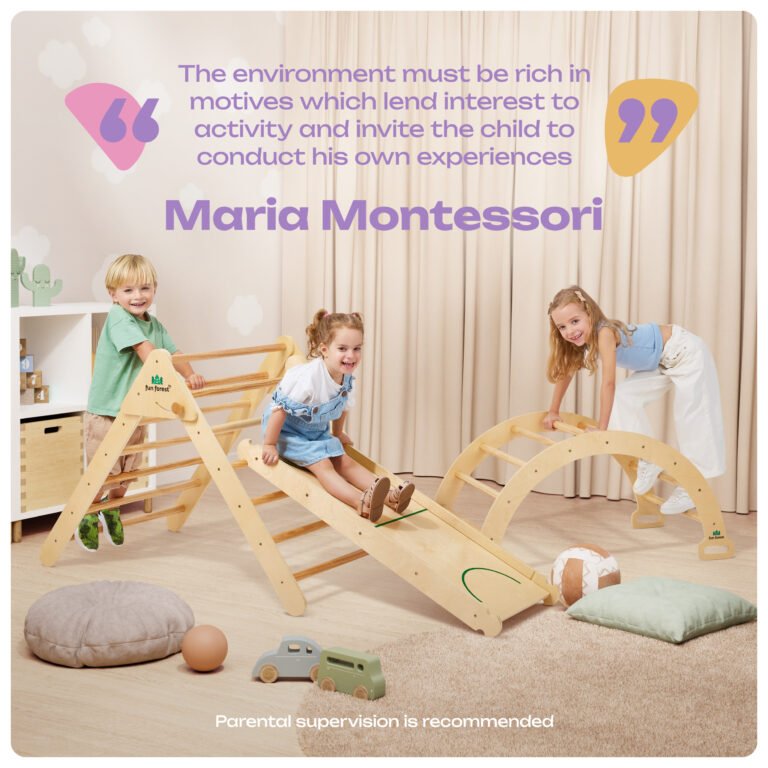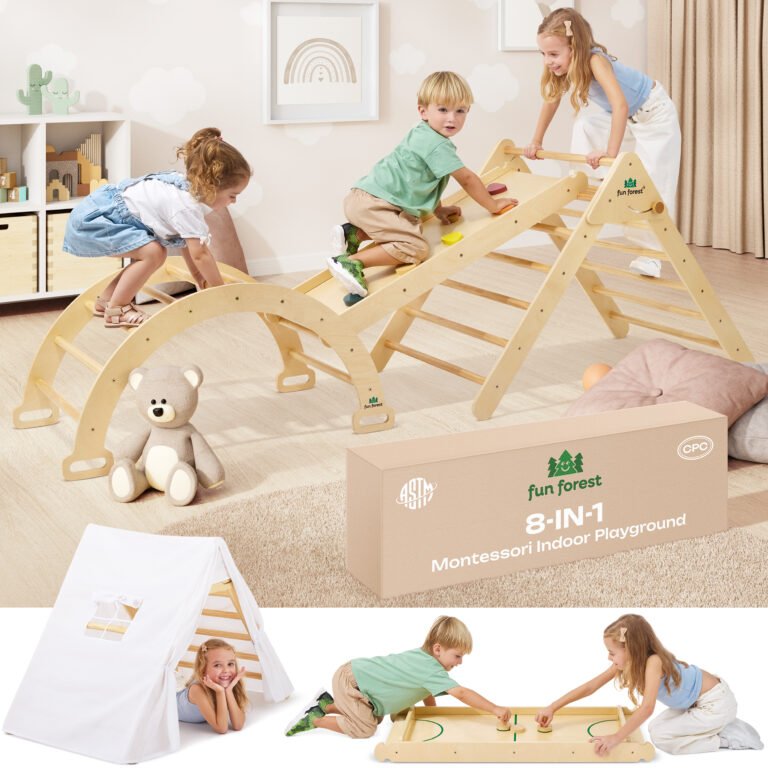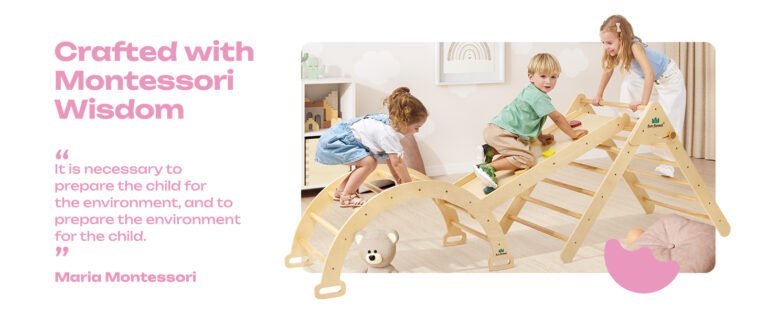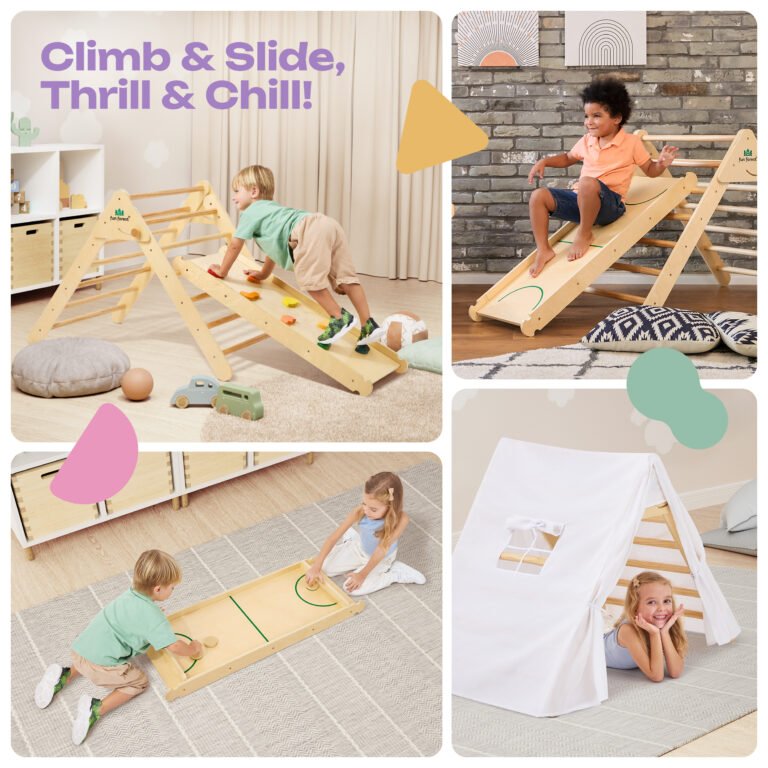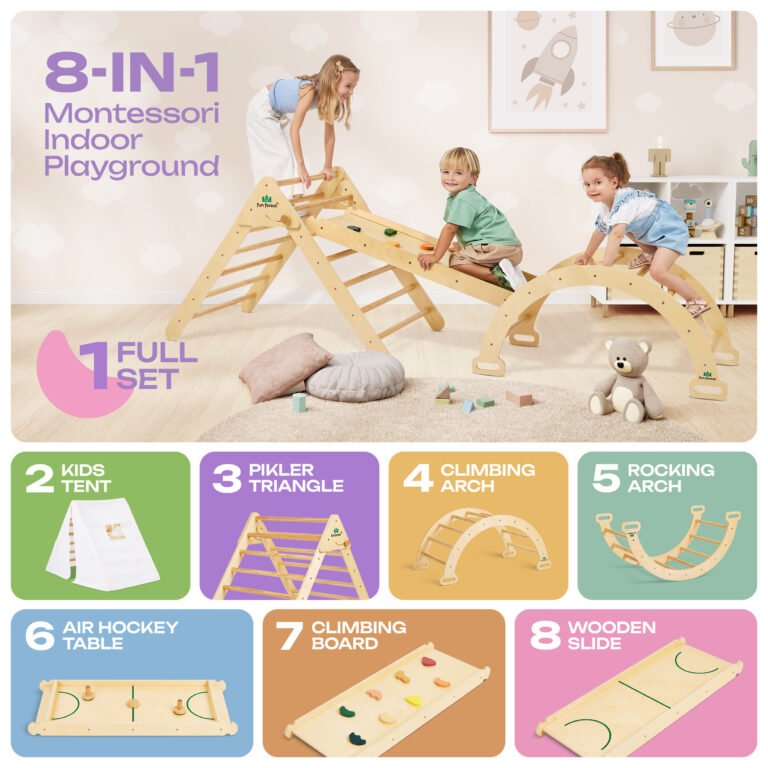Which Climbing Toy is Safest for a 1-Year-Old? A Parent’s Complete Safety Guide
Which Climbing Toy is Safest for a 1-Year-Old? A Parent’s Complete Safety Guide
Watching your one-year-old attempt to scale the couch, coffee table, or anything else they can get their hands on can be both adorable and terrifying. This natural urge to climb is a crucial part of their development, but as a parent, your first concern is keeping them safe while supporting their growing independence and motor skills.
The question isn’t whether your one-year-old should climb—it’s how to provide the safest possible environment for this essential developmental activity. With so many climbing toys on the market, how do you choose one that truly prioritizes safety while supporting your toddler’s natural development?
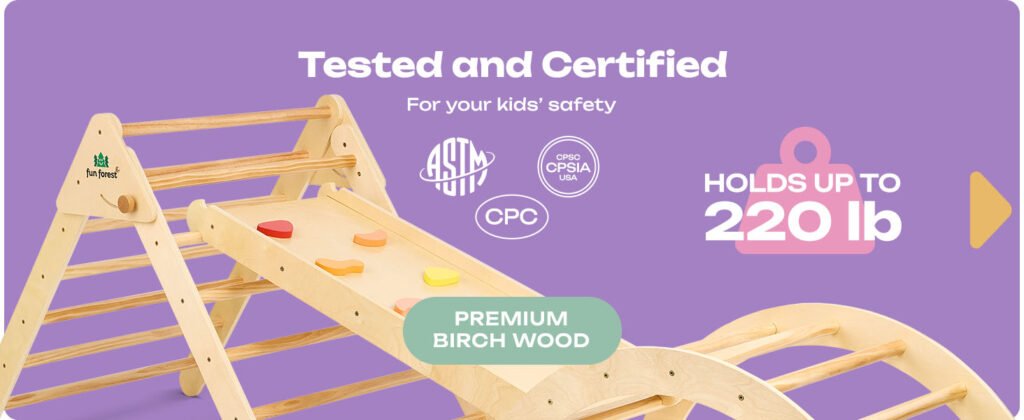
Understanding Your 1-Year-Old’s Climbing Needs
Developmental Stage at 12 Months
At one year old, your child is experiencing an explosion of motor development:
Physical Capabilities:
- Pulling to stand: Using furniture and objects for support
- Cruising: Moving along furniture while holding on
- First steps: Many are walking or close to walking
- Improved balance: Better control of their body in space
- Stronger grip: Ability to hold and pull with more force
Cognitive Development:
- Cause and effect understanding: Learning how their actions create results
- Spatial awareness: Beginning to understand height, distance, and positioning
- Problem-solving: Figuring out how to reach desired objects or places
- Risk assessment: Early development of understanding consequences
Emotional Needs:
- Independence drive: Strong desire to do things themselves
- Confidence building: Success in physical challenges builds self-esteem
- Security: Need for safe exploration within appropriate boundaries
- Achievement satisfaction: Joy from reaching goals and overcoming challenges
Critical Safety Features for 1-Year-Old Climbing Toys
Structural Safety Requirements
Height Considerations:
- Maximum safe height: 24-30 inches for one-year-olds
- Gradual progression: Ability to start low and work up
- Fall distance: Minimize potential injury from falls
- Escape routes: Easy ways to get down safely
Stability Features:
- Wide base: Prevents tipping during enthusiastic climbing
- Low center of gravity: Reduces likelihood of overturning
- Weight distribution: Designed to handle shifting child weight
- Non-slip base: Stays in place during use
Material Safety:
- Non-toxic finishes: Safe if mouthed or licked
- Smooth surfaces: No splinters, sharp edges, or rough spots
- Appropriate hardness: Firm enough for climbing, not so hard as to cause injury
- Weather resistance: If used outdoors, materials must withstand elements
Design Safety Elements
Age-Appropriate Sizing:
- Rung spacing: 6-8 inches apart for small hands and feet
- Rung thickness: Easy for tiny hands to grip securely
- Overall dimensions: Proportioned for one-year-old body size
- Weight capacity: Substantial enough to handle growing toddlers
Safety Surfaces:
- Rounded edges: No sharp corners or angles
- Smooth transitions: Seamless connections between components
- Appropriate texture: Enough grip for safety, not so rough as to cause scrapes
- Quality hardware: Secure connections that won’t loosen with use
Comparing Popular Climbing Toy Options
Plastic Climbing Structures
Pros:
✅ Often lightweight and portable
✅ Bright colors may appeal to children
✅ Weather-resistant for outdoor use
✅ Easy to clean
Cons:
❌ May lack stability due to light weight
❌ Can become brittle and crack over time
❌ Often have sharp edges where pieces connect
❌ May contain harmful chemicals or plasticizers
❌ Limited longevity as child grows
Safety Concerns for 1-Year-Olds:
- Potential tipping due to lightweight construction
- Sharp edges from molding processes
- Chemical safety concerns with mouthing
- Rapid wear leading to structural weakness
Foam Climbing Sets
Pros:
✅ Soft material reduces injury risk
✅ Lightweight and easy to move
✅ Often designed specifically for toddlers
✅ Washable covers available
Cons:
❌ May compress and lose shape quickly
❌ Often lack structural integrity for true climbing
❌ Can harbor bacteria if not properly maintained
❌ Limited challenge as child develops
❌ May not provide realistic climbing experience
Safety Concerns for 1-Year-Olds:
- Insufficient support for developing climbing skills
- Potential hygiene issues with frequent use
- May create false confidence that doesn’t transfer to real climbing
Metal Climbing Structures
Pros:
✅ Very durable and long-lasting
✅ Can support significant weight
✅ Often designed for outdoor use
Cons:
❌ Can be cold to touch in winter
❌ May rust if not properly coated
❌ Often too large and challenging for one-year-olds
❌ Hard surfaces increase injury risk
❌ Usually designed for older children
Safety Concerns for 1-Year-Olds:
- Inappropriate sizing for small children
- Hard surfaces can cause serious injuries
- Often lacks safety features for youngest climbers
Wooden Climbing Triangles (Pikler Triangles)
Pros:
✅ Natural material that’s safe to mouth
✅ Stable, wide-base design
✅ Appropriate sizing for toddlers
✅ Grows with child’s development
✅ Attractive, furniture-quality appearance
✅ Excellent stability and durability
Advantages for 1-Year-Olds:
- Perfect height: Scaled appropriately for beginning climbers
- Natural material: Safe for mouthing and touching
- Stable base: Wide triangle design prevents tipping
- Gradual challenge: Can start with just pulling up and progress to climbing
- Quality construction: Built to last through multiple children
Why Pikler Triangles Excel for 1-Year-Old Safety
Developmental Appropriateness
Perfect Starting Point:
At 12 months, children can use Pikler triangles in developmentally appropriate ways:
- Pulling to stand: Using lowest rungs for support
- Cruising practice: Moving along the base while holding rungs
- First climbing attempts: One or two rungs up with plenty of support
- Balance development: Standing while holding rungs builds stability
- Confidence building: Success at their own pace builds genuine confidence
Growth Accommodation:
Unlike toys designed for specific ages, quality Pikler triangles grow with your child:
- Extended use: Continues to challenge children through age 5+
- Progressive difficulty: Natural advancement as skills develop
- Investment value: Years of use from single purchase
- Sibling sharing: Works for multiple children of different ages
Superior Safety Features
Structural Design:
- Triangle geometry: Inherently stable shape that won’t tip
- Wide base: Provides stability even with enthusiastic climbing
- Appropriate height: Tall enough to challenge, low enough to be safe
- Quality materials: Real wood construction provides durability and safety
Age-Specific Safety:
- Graduated difficulty: Children naturally start easy and progress
- Self-limiting: Design prevents attempts beyond child’s capability
- Soft landing: Appropriate height minimizes fall consequences
- Intuitive use: Children instinctively understand how to use safely
Essential Safety Guidelines for 1-Year-Old Climbers
Environmental Setup
Surface Preparation:
- Soft landing areas: Thick area rugs, foam mats, or carpeting
- Clear perimeter: 3-4 feet of open space around climbing structure
- Remove hazards: Eliminate sharp furniture edges or hard objects nearby
- Adequate lighting: Ensure good visibility for safe climbing
Supervision Requirements:
- Active watching: Stay within arm’s reach during initial uses
- Gradual independence: Slowly increase distance as child demonstrates competence
- Environmental awareness: Monitor for new hazards or changes
- Emergency preparedness: Know how to respond to potential accidents
Usage Guidelines
Time and Frequency:
- Short sessions: 10-15 minutes initially, building as interest and ability grow
- Energy management: Use when child is alert but not overtired
- Regular breaks: Prevent fatigue that could lead to accidents
- Daily routine: Consistent availability helps build skills gradually
Progression Monitoring:
- Skill assessment: Regularly evaluate child’s growing capabilities
- Challenge adjustment: Modify environment as abilities develop
- Safety updates: Adjust safety measures as child becomes more confident
- Growth accommodation: Ensure equipment continues to meet changing needs
The Fun Forest Safety Advantage
When choosing the safest climbing option for your one-year-old, the Fun Forest collection prioritizes safety without compromising developmental benefits:
🌲 Fun Forest Pikler Triangle
Designed Specifically for Toddler Safety:
🛡️ Perfect Height: 30-inch height provides challenge without excessive fall risk
🔒 Superior Stability: Wide triangle base prevents tipping during enthusiastic use
🌿 Natural Safety: Real wood construction is safe for mouthing and touching
📏 Age-Appropriate Sizing: Rung spacing perfect for small hands and feet
✨ Smooth Finish: Hand-sanded surfaces eliminate splinter risk
🏠 Quality Construction: Built to support growing children safely for years
Safety Certifications:
- ASTM F963 toy safety compliance
- Non-toxic finishes certified safe for children
- Structural integrity tested beyond normal use parameters
- Age-appropriate design verified through child development research
🎯 Complete Fun Forest Pikler Set
Comprehensive Safety for Growing Families:
🏆 Multiple Safety Configurations: Various setups accommodate different skill levels
👶 Infant-Safe Components: Some pieces suitable from 6 months with supervision
📈 Growth Adaptation: Components that evolve with your child’s developing abilities
👨👩👧👦 Multi-Child Safety: Designed for families with children of various ages
🔧 Secure Connections: All components tested for safe assembly and use
🎪 Progressive Challenge: Natural advancement from simple to complex configurations
Why Fun Forest Excels for 1-Year-Olds:
Material Excellence:
- Premium hardwood: Naturally antimicrobial and safe for young children
- Non-toxic finishes: Food-safe stains and sealers
- Smooth surfaces: Hand-finished to eliminate any rough spots
- Durable construction: Built to withstand years of enthusiastic use
Design Philosophy:
- Child-led development: Allows natural progression without forcing advancement
- Safety-first engineering: Every design decision prioritizes child safety
- Quality craftsmanship: Attention to detail ensures long-term safety and durability
- Family-focused: Designed for real families with real safety concerns
Red Flags: Climbing Toys to Avoid for 1-Year-Olds
Immediate Safety Concerns:
❌ Excessive height: Anything over 36 inches is inappropriate for beginners
❌ Narrow base: Structures that could tip during use
❌ Sharp edges: Hard plastic or metal with potential injury points
❌ Poor stability: Lightweight structures that move during climbing
❌ Chemical concerns: Strong odors or unknown material safety
❌ Age inappropriateness: Equipment designed for older children
Long-Term Safety Issues:
❌ Rapid wear: Equipment that shows deterioration quickly
❌ Loose connections: Hardware that loosens with normal use
❌ Material degradation: Plastics that become brittle or crack
❌ Inadequate weight capacity: Structures not built for growing children
❌ Poor customer support: Companies that don’t stand behind safety claims
Making the Safest Choice for Your Family
Assessment Questions:
Before choosing any climbing toy for your one-year-old, ask yourself:
- Is the height appropriate for a beginner climber?
- Does the base provide adequate stability?
- Are all materials safe for mouthing and touching?
- Will this grow with my child’s developing abilities?
- Does the manufacturer provide clear safety information?
- Are there appropriate safety certifications?
- Can I easily supervise my child during use?
Investment Considerations:
Safety vs. Cost:
While safety should never be compromised, consider the long-term value:
- Quality construction: Higher upfront cost often means better safety and durability
- Certification costs: Proper testing and certification add to price but ensure safety
- Longevity: Equipment that grows with your child provides better value
- Peace of mind: The confidence that comes with proven safety is invaluable
Growth Planning:
- Future children: Will this work for subsequent children?
- Skill development: Can it accommodate your child’s growing abilities?
- Space considerations: Will it work in your home long-term?
- Resale value: Quality equipment maintains value better
Beyond Safety: Supporting Confident Development
The safest climbing toy for your one-year-old isn’t just about preventing injuries—it’s about providing a foundation for confident, competent development that will serve them throughout their lives.
Building True Confidence:
- Appropriate challenge: Difficult enough to be engaging, safe enough to build confidence
- Natural progression: Allows child-led advancement at their own pace
- Success experiences: Regular achievements build genuine self-esteem
- Risk management: Learns to assess and manage appropriate risks safely
Long-Term Benefits:
- Physical competence: Strong foundation for future athletic and physical activities
- Emotional resilience: Confidence from overcoming physical challenges
- Problem-solving skills: Learning to navigate physical obstacles builds cognitive abilities
- Independence: Physical confidence supports overall independence and self-reliance
Your Child’s Safety Journey Starts Here
Choosing the safest climbing toy for your one-year-old is one of the most important decisions you’ll make for their physical development. It sets the foundation for years of confident movement, appropriate risk-taking, and joyful physical activity.
Ready to give your one-year-old the safest possible start to their climbing adventures?
🌟 Choose the Fun Forest Pikler Triangle – Designed specifically with one-year-old safety and development in mind
🎯 Invest in the Complete Fun Forest Set – Comprehensive safety for your growing family’s changing needs
Your one-year-old’s natural urge to climb is beautiful and important. Give them the safest possible environment to explore this crucial developmental drive. Choose equipment that honors their courage while protecting their safety, supports their growth while respecting their limitations, and builds their confidence while keeping them secure.
Because the safest climbing toy is the one that lets your child be brave, confident, and beautifully, safely themselves.
Learn more in our complete Pikler Triangle guide

